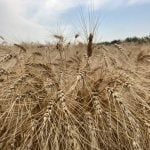Ergot is on the rise and producers should take note, says an Agriculture Canada plant pathologist.
Infection rates for the plant disease doubled in Alberta last year, rising from 15 to 16 per cent of samples tested in 2010 to about one-third in 2011, Kelly Turkington, a plant pathologist in Lacombe, told attendees at FarmTech.
“This is a significant downgrading and a significant impact on producers’ pocketbooks,” said Turkington.
In 2010, the Prairie average for ergot on wheat was about nine per cent, with the highest rates in Alberta. Eight per cent of samples collected in Manitoba and five per cent in Saskatchewan were contaminated by the disease.
Read Also

Alberta has adequate feed supplies going into winter
Hay yields across Alberta were varied, but one expert says feed supplies are in strong supply for Alberta producers for the upcoming winter.
Cool and wet conditions in June and July were the main factors, with the area around Stettler and Crossfield the most affected by ergot in 2011.
The fungal disease affects cereals including triticale, rye, wheat and barley and reduces grade. The fungus produces scelerotial bodies that contain chemicals that can affect both humans and livestock. The fungus survives on or in the soil surface, germinates when there is sufficient moisture, and releases thousands of spores into the air. These spores land on the female reproductive parts of cereals and germinate. The fungus then begins to grow and enters “the honeydew phase,” during which it produces masses of spores, which sit in a sugary substance. The sugar is attractive to insects, who feed on that material and transfer the mixture to adjacent plants, spreading the disease.
Rye and triticale flowers, which cross-pollinate, remain open for longer while crops such as wheat and barley, which self-pollinate, have closed flowers, and can’t be infected as easily. Crop rotation can be key in combating infestations.
“You want to avoid planting wheat after rye or triticale. Typically and traditionally the recommendation has been a one-year break between cereal crops to allow for decomposition of scelerotial bodies,” said Turkington.
But Turkington recommends a two-year break between cereal crops.
Ergot also affects tame and wild grasses, so mowing ditches and field margins can prevent the grass from heading and spreading the disease. Producers should make sure their seed doesn’t contain ergot and plant an inch to two or three inches below the soil surface.
“At those depths, it’s simply too deep for that ergot fungus to germinate and produce fruiting structures that will reach the soil surface,” Turkington said.
Most strategies that limit infection rates focus on pollen viability and sterility.
“If you have a boron or copper deficiency, adding these two nutrients in the fungal fertilizer may help to reduce the risk of ergot,” said Turkington.
Other stresses put on the crop can reduce the risk of pollen sterility, increasing the risk of ergot. Late herbicide applications interfere with reproductive growth and should be avoided. Cold or warm snaps can lead to pollen viability issues as the cereal head is emerging from the boot. Increasing the seeding rate can help prevent ergot, as can delaying swathing or harvest.















